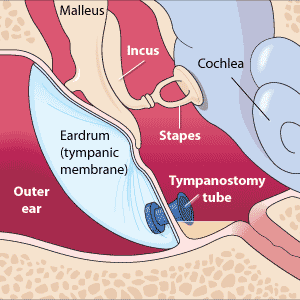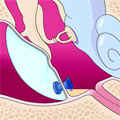Description of the procedure
A myringotomy with tympanostomy tube insertion is one of the most common surgical procedure for children. A myringotomy is a surgical procedure where a small incision is made in the eardrum (tympanic membrane), typically in both ears. Small plastic tubes (tympanostomy tubes), open at both ends, are then inserted into the incisions.
These tubes are often used in cases where children have long-lasting middle ear infections or fluid buildup. They allow fluid to drain out of the middle ear, which prevents pressure from building up. The tubes also allow air to move in and out of the middle ear.
The procedure can be performed in various locations, including hospital operating rooms, outpatient clinics, and doctor's offices, most commonly using general anesthesia.
When should this procedure be performed?
This procedure is performed by a doctor as needed.
Why is this procedure performed?
A tympanostomy tube insertion may be recommended if your child has one of the following conditions:
- fluid buildup in the middle ear lasting more than 3 months
- recurrent middle ear infections that have not responded adequately to antibiotic treatment over several months
- hearing loss due to fluid buildup in the middle ear
- delayed speech development due to fluid buildup in the middle ear
Tympanostomy tube insertion allows air to move in and out of the middle ear, and for fluid to drain. This helps prevent permanent hearing loss as well as speech and learning impairment. The procedure also helps reduce recurrent middle ear infections.
Are there any risks and precautions?
Certain risks are common to all surgery and anesthesia. These risks depend on many factors including the type of surgery and your own medical condition. The possible, but very rare, side effects include: side effects of the anesthetic, breathing problems, infection, bleeding, scarring, and death.
Although tympanostomy tube insertion is generally considered safe, it does have some risk of side effects or complications. These include:
- scarring or thickening of the eardrum
- a permanent hole in the eardrum
- damage to the outer ear
- hearing loss
- ongoing fluid discharge from the ear
- the tube falling out prematurely or staying in too long
If your child experiences these side effects or complications, contact their doctor immediately.
If you are concerned about any symptoms following this procedure, speak to your child’s doctor. Take the time to be sure you understand all the risks of complications and side effects as well as any precautions your child or your doctor can take to avoid them. Be sure the doctor understands all your concerns.
What happens during the procedure?
- If general anesthetic is being used, the doctor will put the child to sleep. Or, if a local anesthetic is being used, the doctor will numb the area.
- Next, the doctor will make a small incision in the eardrum through the outer ear canal.
- Fluid is removed through the incision, then the ear tubes are inserted. Fluids will flow out of the ear through these tubes.
- The ears are plugged with cotton to control bleeding.
In time, the eardrum heals around the ear tubes, securing them. The ear tubes usually fall out naturally after 6 to 12 months. They can also be removed by your doctor.
The procedure usually takes approximately 15 minutes.
How should I prepare for this procedure?
Before having this procedure, discuss the advantages, disadvantages, long-term risks and consequences associated with the procedure with your child’s doctor. Be sure you fully understand what will happen and are comfortable with your child’s doctor’s answers to your questions.
If a general anesthetic will be used, ensure your child does not eat for 8 hours before the procedure. Your child may continue to drink clear liquids until 2 hours before the procedure. If your doctor has recommended different times, follow the timing recommended by your doctor.
Tell your doctor or prescriber about all prescription, over-the-counter (non-prescription), and herbal medications that your child is taking. Also tell them about any medication allergies and medical conditions that your child may have. Arrange for someone to drive your child home from the hospital, clinic, or office.
Ask your doctor or pharmacist whether your child needs to stop taking any of his or her medications before the procedure.
What can I expect after the procedure?
Most children are able to resume normal activities within a day of the surgery.
There is some controversy as to how important it is to keep water out of the ear. However, while the eardrum is healing, your surgeon may recommend that your child wears a shower cap while bathing or showering to keep water out of the ear canal.
Your child's doctor may also recommend that children with ear tubes wear ear plugs when swimming. Pain medications or ear drops may also be recommended to help during the healing process and to prevent infection.
Results
After a successful procedure, your child's hearing should improve and you should notice fewer ear infections. Learning and speech development may also improve as a result.
All material copyright MediResource Inc. 1996 – 2024. Terms and conditions of use. The contents herein are for informational purposes only. Always seek the advice of your physician or other qualified health provider with any questions you may have regarding a medical condition. Source: www.medbroadcast.com/procedure/getprocedure/Tympanostomy-Tube-Insertion



